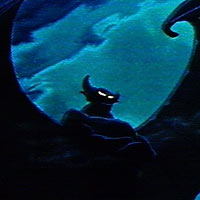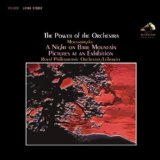A Night on Bald Mountain
Mussorgksy's Terrifying Tone Poem
A Night on Bald Mountain is one of Modest Mussorgsky's most well-known pieces. The frantic, demonic musical thunderbolt has frightened listeners for over a century!
Lots of people recognize the piece since it was included (in an arranged version by Leopold Stokowski) in the 1940 film Fantasia. The versions most heard are actually either by Nikolai Rimsky-Korsakov or the Stokowski. Mussorgsky's original is quite rare!
Click to read a biography of Rimsky-Korsakov.
The piece actually grew out of several opera projects which Mussorgsky started and stopped, due to laziness or alcohol (or both).
Like his other famous piece, Pictures at an Exhibition, Mussorgky wrote A Night on Bald Mountain ridiculously quickly.
He finished it completely in 12 days, in a blaze of creativity. He didn't even bother making a first draft - he simply exploded his brain onto the page, creating the final version in one go!
The date the it was finally finished was St John's Eve (June 23 1867), which is why the original title is actually St John's Night on the Bald Mountain.

Later on, Mussorgsky adapted it twice for two unfinished operas, changing some parts.
True to his artistic goals, Mussorgsky told a friend that Night on Bald Mountain "is, in form and character, Russian and original; and I want to feel sure that it is thoroughly in keeping with historic truth and Russian folk tradition".
Sadly though, the composer never heard his diabolical tone poem, since it wasn't performed at all while he was alive.
Five years after he passed away Rimsky-Korsakov took bits and pieces from all three versions and smashed them together, create the world-famous diabolical thunderclap everyone loves today.
 Rimsky-Korsakov's version was more of a reconstruction.
Rimsky-Korsakov's version was more of a reconstruction. He tried to keep as much of Mussorgsky's original ideas as possible, and put in the least amount of his own material he could.
A Night on Bald Mountain is was inspired by Russian and Gogol mythology.
The basic story depicts dark witches' ritual, conjuring up the devil on a bleak mountaintop. The "bald mountain" isn't really any particular mountain in the world - it's just meant to be a barren mountain without any trees or shrubs.
Both Mussorgsky's original version and Rimsky-Korsakov's reconstruction have a little program describing what happens in the piece. Let's have a look at both of them...
Mussorgsky's version:
Interestingly Mussorgsky's version doesn't have any kind of calm, light second half. The entire piece is one long whirlwind of evil. Rimsky-Korsakov's version changes character halfway through though...
Rimsky-Korsakov's version
Subterranean sounds of unearthly voices. Appearance of the Spirits of Darkness, followed by that of the Chernobog (the "Black God").
Glorification of Chernobog and celebration of the Black Mass. Witches' Sabbath. At the height of the orgy, the bell of the little village church is heard from afar.
The Spirits of Darkness are dispersed. Daybreak.
Quite a ride, isn't it!
One of my favorite recordings of A Night on Bald Mountain is this blistering performance by Rene Liebowitz conducting the Royal Philharmonic Orchestra. Out of all the recordings I've heard, this one comes across as the boiling mass of evil that the piece ought to be!
Another blistering recording is from conductor Fritz Reiner, with the Chicago Symphony Orchestra from the 1950s, remastered in 1993. Although it's an old recording, the performance is electric, with terror-inducing speed and energy and a slightly off-kilter rhythm which perfectly evokes the unearthly spirits depicted in the piece.
The recording quality is great as well considering the age of the performance. Top marks! As a bonus there's also a fantastic performance of Mussorgsky's Pictures at an Exhibition.
Want more Mussorgsky? Have a listen to Pictures at an Exhibition, another famous piece by this Russian genius.
Or explore the works of his contemporaries Borodin and Tchaikovsky.
If you like my site, please click "Like"... thanks!



